There are a lot of reasons you might change your domain name, including rebranding a business, resolving a copyright complaint, or changing industries. Whatever the reason, it can be hard to migrate sites and set up your new domain without losing your web data or customer base.
In this guide, I’ll walk through the steps you should take to make your domain name change as painless as possible and how to avoid losing your site in the process and starting again from scratch.
Read our guide to the seven best domain registrars for a full review of what we loved about each one.
Change Your Domain Name in 8 Easy Steps
Changing your domain name can feel overwhelming, but with the right steps and tools, it’s actually a lot easier than most people expect it to be. Here’re the eight steps I’ll be breaking down in this guide:
- Check The Domain Change Rules For Your Host Provider
- Backup Your Current Site
- Choose A New Domain Name
- Purchase Your New Domain Name
- Set Up Migration
- Set Up Redirects
- Update Google Tools
- Contact Any Customers Or Clients Via Email
Step 1: Check The Domain Change Rules For Your Host Provider
The first thing you’ll want to do when you’re getting ready to change your domain name is to check the specific rules for your host provider about domains.
Every host will have different regulations about changing your domain and which processes you need to use, especially when transferring a domain or adding a second domain.
It’s worth mentioning here that when talking about “changing” a domain, we’re really talking about migrating a site by purchasing a new domain and using that to replace your primary domain. There’s no real way to “change” a domain that’s not expired, so you’ll have to buy a new domain and keep the old one until it expires or sell it.
Depending on who your host provider is and your plan with them, you may be able to add websites to your account for free, like if you’re using GoDaddy’s Deluxe plan. If not, then you’ll have to buy another domain and either upgrade your account or set up hosting with another company.
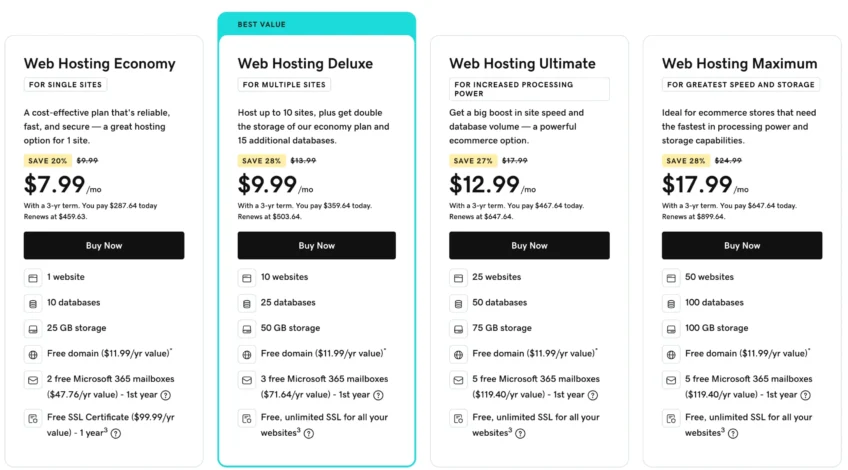
Step 2: Backup Your Current Site
Before you can buy a new domain or migrate your content, you need to back up your site. This is very important because many things can go wrong when migrating sites, and having to set up your site all over again will set you back hours or even weeks.
Again, whichever hosting provider you use will have different ways of doing this, but most offer an easy download option for backing up your site and saving it to both the cloud and a device. For example, GoDaddy has a built-in tool to back up your site directly to your account.
You can also use a backup plugin, like Updraft Plus or All In One WordPress Migration, to make a copy of your site and download it to an external source, like your computer or dropbox. This is a better option if you are moving to a new host provider and changing your domain name. If you’re staying with the same host (for example, you’re migrating your site from your main domain to a new domain in GoDaddy), you don’t have to worry about this as much.
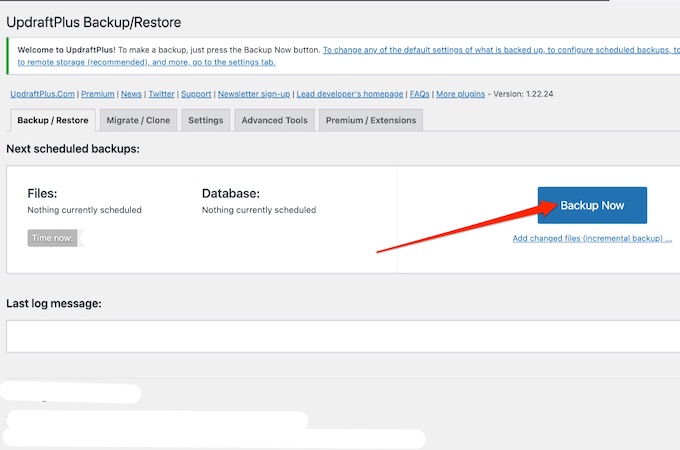
I recommend backing your site up in multiple locations, like your computer and a cloud tool, so you’ll have the peace of mind that your site is safe. It will also make the process of changing a domain name much faster and easier instead of feeling like you’re launching a new site from scratch again.
Step 3: Choose A New Domain Name
Before you can change your domain name, you need to choose the new domain you’ll be sending traffic to.
This is the easy part because if you’re thinking about changing your domain name, you probably already have a new one in mind. When you are choosing a new name, it’s important to consider the same things you would when purchasing your first domain, like:
- Availability: You can use a tool like GoDaddy’s domain name search bar to see if your domain is available for purchase
- Originality: Is it close enough to someone else’s business name, domain, or social media that you could risk being accused of copyright infringement?
- Relevance: Is your domain relevant to your business? Is it recognizable as being related to your brand and memorable for customers?
- Accessibility: Is your domain easy to spell? Is it short and easy for anyone to type?
Although this is an easy step, I want to stress how important it is to get this right. You don’t want to spend money on a new domain and go through the process of changing your brand’s name, only to have to do it all again in a few months. Take your time with this step and make sure that if you’re going to change your domain name, it’s worth it. You can then look for your domain using GoDaddy’s domain search tool.
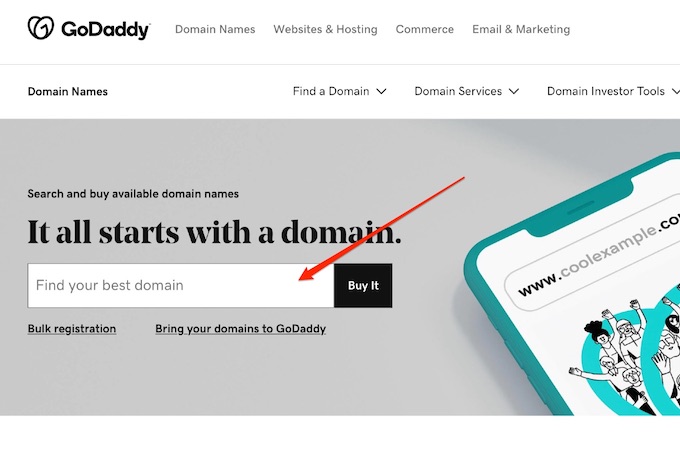
Step 4: Purchase Your New Domain Name
Once you’ve chosen your domain name, you can purchase it. You can do this in three main ways, although the last is a little more complicated than the other.
If you’re using GoDaddy and have a plan that supports multiple sites, the easiest way is to purchase your domain directly as you set up your new site. To do this, go to your GoDaddy product page. Click on Websites + Marketing and select Manage next to your website. Then, click Edit Website to access your site builder and select Settings, and click Manage next to your domain name. You’ll then see the option to Get a New Domain. From here, you’ll be able to purchase your new domain name from GoDaddy and connect it to your site directly.
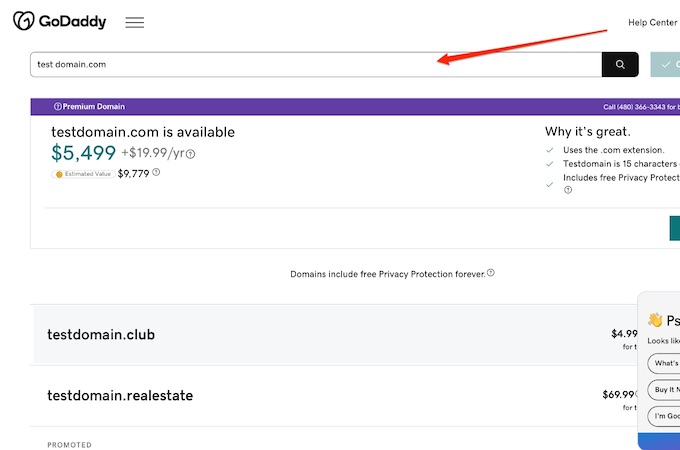
The second option is to purchase your new domain name through your current host provider as a second domain. For example, with the GoDaddy Deluxe plan, you can simply set up a second site and buy a new domain within one account.
The third option is to set up your domain with a new hosting provider. This is more expensive and will make migrating your site more difficult, but it might make sense for you if you want to move hosts for financial or technical reasons. When you sign up for a new hosting plan, you’ll probably get a free domain included in your plan, so you can make your new domain name your main one.
Step 5: Set Up Migration
Once you’ve purchased your new domain name and have it set up as a secondary or main domain, you need to migrate your old site to the new domain.
If you are using a secondary domain, this is pretty easy. With GoDaddy, you only need to go to your GoDaddy product page. From there, go to Websites + Marketing, then click on Manage next to your website to access your site.
Then choose Edit Website to open your website builder, and click Select Settings. Then, click on Manage next to your domain name. Select I Already Own The Domain. Then click on Choose a Domain and select the new domain you’ve added to your account. Once you’ve checked that you’ve selected the correct domain, click save and publish.
If, for any reason, something goes wrong, or if you are moving to a new hosting provider entirely, you might want to migrate your site manually using a plugin. For this, you must first check that your website DNS (found in your settings under your hosting account) is updated to your new site.
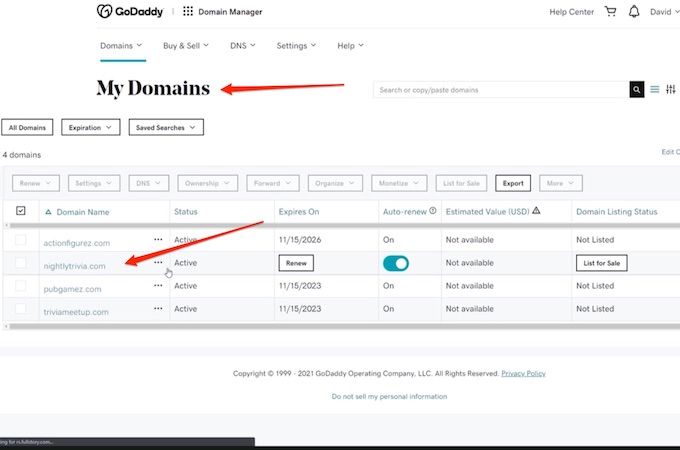
Then, you can import your website backup to your new site. Make sure you have created a basic new site first (using a template theme, for example) before uploading your site backup and importing your old content using your downloaded files and the instructions from your plugin.
Both these options can take a couple of days to kick in, so be patient if your hosting provider takes a little time to update these changes and reflect them on your new site. This is why it’s a good idea to keep your old domain active for a few days while you complete the necessary changes to your new site.
Step 6: Set Up Redirects
Once you’ve set up your domain name and the accompanying site, you need to ensure all your old URLs redirect traffic to your new site. You can do this easily from your domain dashboard on your hosting site.
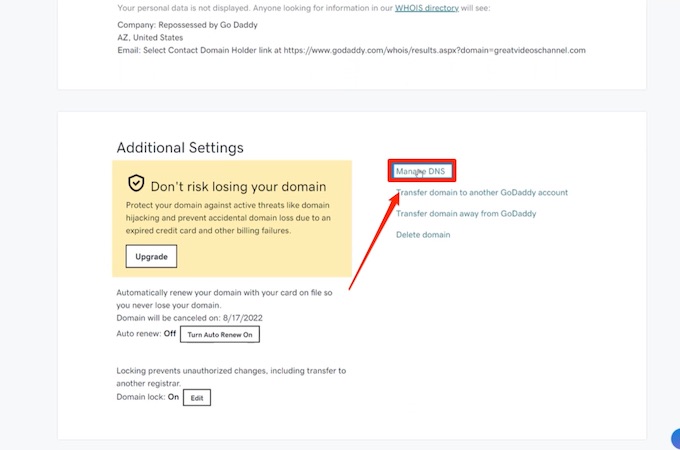
In GoDaddy, you just need to go to Account Settings and go into your domains. From there, choose the domain that you will be forwarding (your old domain) and click Manage DNS. If you scroll down this page, you’ll see a section that says Forwarding. From here, you can set up forwarding for both your domain and subdomains.
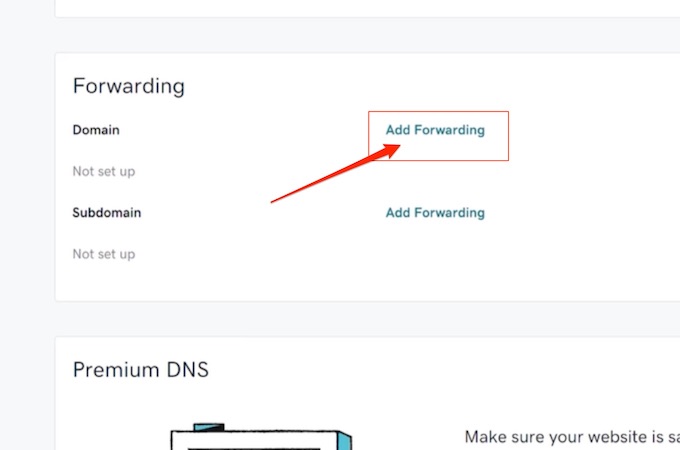
After choosing Forward Domain next to your old domain, you can add your new domain name URL and choose a type of redirect link. You can choose between a 301 or a 302 redirect. Although they both work, I’d recommend using a 301 permanent redirect as it’s faster and preserves the most SEO value generated by your original site.
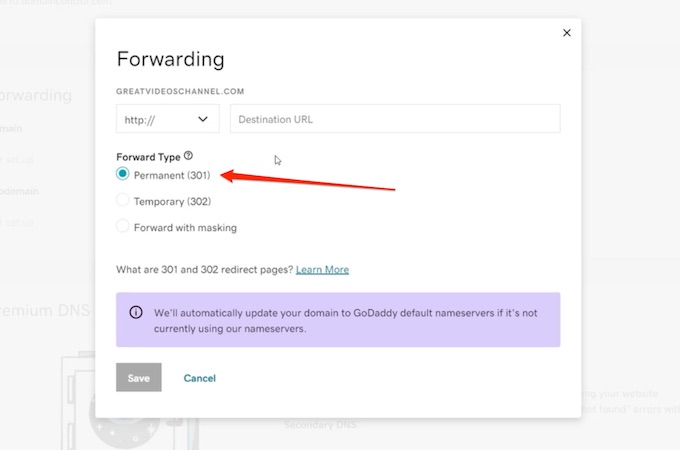
By setting up redirects, you’ll minimize your chances of losing traffic and make it easier for both new and old site visitors to find your new domain.
Step 7: Update Google Tools
Once your new domain name is set up, you need to update Google Console and Google Analytics.
For Google Console, you only need to log in to your account and select the gear icon. This will take you to your Settings, where you’ll select Change of Address. Then, add your new domain, and Google can send redirects to your new site.
With Google Analytics, you just need to go to Admin, choose the property you want to edit (in this case, your old domain), and then edit the default URL to your new one.
Step 8: Contact Any Customers Or Clients Via Email
The last step for changing your domain name is to let your users, customers, or audience know that you’ve changed your domain name.
This is optional, but if you have a blog or an online store, it’s a good idea to reduce the amount of traffic you’ll lose from your domain change and make sure that people know it’s happening.
All you need to do is send out a short announcement via social media or email, letting your audience know that you’ve changed the domain name and rebranded your site. A smart move here is to invite them to visit or bookmark the new site to improve your SEO and get your traffic numbers up from the start.
Final Thoughts About Changing Your Domain Name
Changing your domain name is a necessary but daunting process. Getting it wrong can waste a lot of your time, but by following this simple step-by-step guide, you can see how easy it is to change your domain name without losing traffic or customers along the way.
